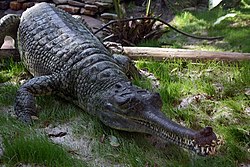インドガビアル科
| インドガビアル科 | |||||||||||||||||||||||||||||||||
|---|---|---|---|---|---|---|---|---|---|---|---|---|---|---|---|---|---|---|---|---|---|---|---|---|---|---|---|---|---|---|---|---|---|
 
| |||||||||||||||||||||||||||||||||
| 分類 | |||||||||||||||||||||||||||||||||
| |||||||||||||||||||||||||||||||||
| 学名 | |||||||||||||||||||||||||||||||||
| Gavialidae Adams, 1854 | |||||||||||||||||||||||||||||||||
| 属 | |||||||||||||||||||||||||||||||||
インドガビアル科[1](インドガビアルか、学名:Gavialidae)またはガビアル科(ガビアルか)は、インドガビアルを含むワニ目の系統群。伝統的に現生種ではインドガビアル1種のみを含むとされていたが、分子系統解析によりマレーガビアルも本科に属することが示されている。化石種ではピスコガビアリスやグリポスクスのほか、トミストマ亜科に属するトヨタマヒメイア(マチカネワニ)などが含まれる。細長い吻部を特徴とする。
分類
[編集]インドガビアル科は1854年にアーサー・アダムスにより、非常に長く細長い吻部や水かきのある脚などの特徴を持つ爬虫類として命名された[2]。インドガビアル科はクラウングループと認識されており[3]、現生インドガビアル科(インドガビアルとマレーガビアル)の最も近い共通祖先とその全ての子孫の身を含む。なお、ここでの子孫には化石種も含まれる。
伝統的に、クロコダイルとアリゲーターは互いにインドガビアルよりも近縁と考えられ、現生種や化石種の骨格形態から、ブレヴィロストレス類という分類群が考えられていた[4]。しかし、後のDNAシークエンシングを用いた分子系統解析で、クロコダイルとガビアルがアリゲーターよりも互いに近縁であることが判明し[5][6][7][3][8]、Longirostres (en) という分類群が Harshman et al., 2003 で提唱された[5]。
さらに、DNA研究ではマレーガビアルがガビアル上科のトミストマ亜科に位置付けられた[5][9][10][6][7][3][8]。それまではマレーガビアルは外見こそ類似するもののインドガビアルとは遠縁のクロコダイル上科に分類されていたが、これらの論文によりマレーガビアルと他のトミストマ亜科のワニをガビアル科に位置付ける見解も登場している[9]。
2018年には形態情報・分子情報・層序情報を用いた Lee と Yates によるワニ目内の系統解析が発表され[3]、2021年には Hekkala らがヴォアイ属の古ゲノムを利用してこれを支持している[8]。以下にクラドグラムを示す。
| ワニ目 |
| ||||||||||||||||||||||||||||||||||||||||||||||||||||||||||||||||||||||||||||||||||||||||||||||||
| (クラウングループ) |
Lee と Yates は、ガビアル科内での絶滅属種の系統関係も提唱している[3]。この解析結果では、トミストマ亜科は側系統群となっている。
| ガビアル科 |
| ||||||||||||||||||||||||||||||||||||||||||||||||||||||||||||||||||||||||
なお、日本語文献ではトミストマ亜科は依然としてクロコダイル上科に位置付けられることが多い。小林快次による『ワニと恐竜の共存 巨大ワニと恐竜の世界』(2013年)ではトミストマ亜科はクロコダイル亜科と共にクロコダイル科を二分するグループとして紹介されている[1]。小林の監修を受けた土屋健による『地球生命 水際の興亡史』(2021年)においても、マチカネワニはクロコダイル類として紹介されている[11]。
出典
[編集]- ^ a b 小林快次『ワニと恐竜の共存 巨大ワニと恐竜の世界』北海道大学出版会、2013年7月25日、50-51頁。ISBN 978-4-8329-1398-1。
- ^ Adams, A. (1854). “II. Order – Emydosaurians (Emydosauria)”. In Adams, A.; Baikie, W. B.; Barron, C.. A Manual of Natural History, for the Use of Travellers: Being a Description of the Families of the Animal and Vegetable Kingdoms: with Remarks on the Practical Study of Geology and Meteorology. London: John Van Voorst. pp. 70–71
- ^ a b c d e Michael S. Y. Lee; Adam M. Yates (27 June 2018). “Tip-dating and homoplasy: reconciling the shallow molecular divergences of modern gharials with their long fossil”. Proceedings of the Royal Society B 285 (1881). doi:10.1098/rspb.2018.1071.
- ^ Holliday, Casey M.; Gardner, Nicholas M. (2012). Farke, Andrew A. ed. “A new eusuchian crocodyliform with novel cranial integument and its significance for the origin and evolution of Crocodylia”. PLOS ONE 7 (1): e30471. Bibcode: 2012PLoSO...730471H. doi:10.1371/journal.pone.0030471. PMC 3269432. PMID 22303441.
- ^ a b c Harshman, J.; Huddleston, C. J.; Bollback, J. P.; Parsons, T. J.; Braun, M. J. (2003). “True and false gharials: A nuclear gene phylogeny of crocodylia”. Systematic Biology 52 (3): 386–402. doi:10.1080/10635150309323. PMID 12775527.
- ^ a b Gatesy, J.; Amato, G. (2008). “The rapid accumulation of consistent molecular support for intergeneric crocodylian relationships”. Molecular Phylogenetics and Evolution 48 (3): 1232–1237. doi:10.1016/j.ympev.2008.02.009. PMID 18372192.
- ^ a b Erickson, G. M.; Gignac, P. M.; Steppan, S. J.; Lappin, A. K.; Vliet, K. A.; Brueggen, J. A.; Inouye, B. D.; Kledzik, D. et al. (2012). Claessens, Leon. ed. “Insights into the ecology and evolutionary success of crocodilians revealed through bite-force and tooth-pressure experimentation”. PLOS ONE 7 (3): e31781. Bibcode: 2012PLoSO...731781E. doi:10.1371/journal.pone.0031781. PMC 3303775. PMID 22431965.
- ^ a b c Hekkala, E.; Gatesy, J.; Narechania, A.; Meredith, R.; Russello, M.; Aardema, M. L.; Jensen, E.; Montanari, S. et al. (2021-04-27). “Paleogenomics illuminates the evolutionary history of the extinct Holocene “horned” crocodile of Madagascar, Voay robustus” (英語). Communications Biology 4 (1): 1–11. doi:10.1038/s42003-021-02017-0. ISSN 2399-3642.
- ^ a b Gatesy, Jorge; Amato, G.; Norell, M.; DeSalle, R.; Hayashi, C. (2003). “Combined support for wholesale taxic atavism in gavialine crocodylians”. Systematic Biology 52 (3): 403–422. doi:10.1080/10635150309329.
- ^ Willis, R. E.; McAliley, L. R.; Neeley, E. D.; Densmore Ld, L. D. (June 2007). “Evidence for placing the false gharial (Tomistoma schlegelii) into the family Gavialidae: Inferences from nuclear gene sequences”. Molecular Phylogenetics and Evolution 43 (3): 787–794. doi:10.1016/j.ympev.2007.02.005. PMID 17433721.
- ^ 土屋健『地球生命 水際の興亡史』技術評論社、2021年7月15日、144-160頁。ISBN 978-4-297-12232-4。
